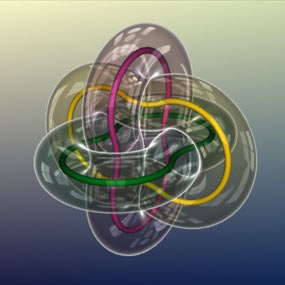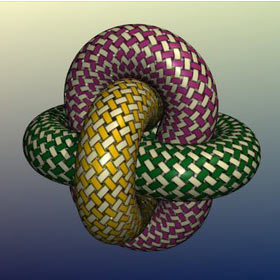IMU Logo History
 The International Mathematical Union (IMU) adopted the logo on the left in 2006, following an international competition launched in 2004. The selected logo was announced on 22 August 2006 at the opening ceremony of the International Congress of Mathematicians (ICM 2006) in Madrid.
The International Mathematical Union (IMU) adopted the logo on the left in 2006, following an international competition launched in 2004. The selected logo was announced on 22 August 2006 at the opening ceremony of the International Congress of Mathematicians (ICM 2006) in Madrid.
The logo was designed by John Sullivan, Professor of Mathematical Visualization at the Technical University of Berlin (TU Berlin) and at the DFG Research Center MATHEON, and adjunct professor at the University of Illinois, Urbana (UIUC), with help from Prof. Nancy Wrinkle of Northeastern Illinois University.
The current logo is a flattened version of this logo.
Borromean rings
The logo design is based on the Borromean rings, a famous topological link of three components. The rings have the surprising property that if any one component is removed, the other two can fall apart (while all three together remain linked). This so-called Brunnian property has led the rings to be used over many centuries in many cultures as a symbol of interconnectedness, or of strength in unity.
Although the Borromean rings are most often drawn as if made from three round circles, such a construction is mathematically impossible.
The IMU logo instead uses the tight shape of the Borromean rings, as would be obtained by tying them in rope pulled as tight as possible. Mathematically, this is the length-minimizing configuration of the link subject to the constraint that unit-diameter tubes around the three components stay disjoint. This problem and its solution are described in the paper Criticality for the Gehring Link Problem by J.Cantarella, J.Fu, R.Kusner, J.Sullivan, N.Wrinkle, Geometry and Topology 10 (2006), pp. 2055–2115, also available at arXiv.org/math/0402212.
Although this critical configuration is quite close to one made of convex and concave circular arcs, its actual geometry is surprisingly intricate. Each component is planar and piecewise smooth, with the shapes of many of the 14 pieces described by elliptic integrals. The improvement over the similar piecewise circular configuration leads to a savings of length of less than one tenth of one percent!
(The paper cited above first noticed a similar surprise in the simple clasp: one rope attached to the floor clasped around another attached to the ceiling. There as well, the minimizing shapes for the ropes are quite complicated, leaving a small gap between the thick tubes right at the tip.)
The tight configuration of the Borromean rings has pyritohedral symmetry (3*2 in the Conway/Thurston orbifold notation), and the IMU logo uses a view along a three-fold axis of rotation symmetry. Instead of the thick tubes, which would touch one another all along their lengths, thinner tubes are drawn, allowing a better view of the link.


Logo video
Sullivan says the new logo "represents the interconnectedness not only of the various fields of mathematics, but also of the mathematical community around the world." Together with Charles Gunn of TU Berlin, he has made a 5-minute computer-graphics video The Borromean Rings: a new logo for the IMU for presentation at the ICM opening ceremony.
The video, also viewable online, includes other views of the tight Borromean rings, rendered for instance as woven rope or transparent soap film.
Script for the video
Credits from the video
A new logo for the IMU
Charles Gunn and John M. Sullivan
Geometry and Visualization
Department of Mathematics
Technische Universität Berlin
- Produced at: 3D Labor Department of Mathematics, TU Berlin DFG Research Center MATHEON
- Postproduction: Samy Khadem
- Software used: jReality (www.jReality.de) with: Surface Evolver, RenderMan, AVN
- Programming support: Nils Bleicher, Bernd Gonska, Martin Sommer
- Sound enginerring: Immanuel Aldag (Telefactory)
- IMU Logo design: John M. Sullivan with Nancy Wrinkle
- Tight Borromean Rings: J. Cantarella, J. Fu, R. Kusner, J. Sullivan, N. Wrinkle Criticality for the Gehring Link Problem www.arXiv.org/math.DG/0402212 Geometry and Topology 10 (2006) pp. 2055–2115
- Photo credits: Peter Cromwell, Philippe Lavergne, John M. Sullivan
- Thanks to: George Francis, Rob Kusner, Stuart Levy, Ines Putz, Nancy Wrinkle, The Geometry Center (Minneapolis), NCSA and the University of Illinois, jReality development team, TU Geometry and Visualization group